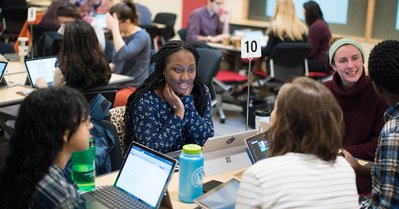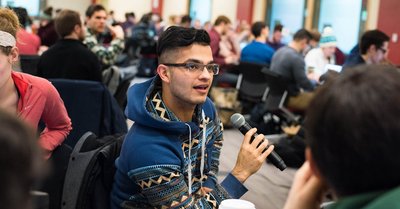
At the University of Vermont Larner College of Medicine, the traditional lecture is on its way out. By 2019, all classes will be based on active learning methods featuring collaboration, simulation, small-group sessions, and flipped classrooms. This effort to transform the curriculum is based on sound evidence. Data show that these techniques produce better results for students, both in terms of test scores and information retention.
“We know that these efforts improve outcomes,” says William Jeffries, PhD, senior associate dean for medical education at the college. “And that’s what we’re really focusing on.”
What does this shift look like from the student perspective? On a typical day in the Larner Classroom, students cluster in small groups at tables scattered throughout the space, conversation buzzing. Large screens around the room show details of a clinical case on the agenda for the day. As each student group weighs the list of potential diagnoses in the hopes of coming to a consensus, the professor stops at different tables to listen in on the discussion and occasionally chime in. When they’ve settled on a diagnosis, each group displays a letter indicating their choice. Where there’s disagreement, group members present the reasons for their choice, often asking questions of each other to hone in on how each team approached the problem, learning valuable lessons in the process.
Through this activity, not only are students applying the medical knowledge they’re learning, but they are also practicing how to work in a team and effectively communicate.
“It’s all in the service of training doctors who are ready to tackle the challenges of 21st century medicine,” says Larner Endowed Professor of Medical Education Kathryn Huggett, PhD. “Especially when active learning requires team work, it more closely resembles a real-world experience.”

Active learning harnesses the digital space to prepare students for the work they do together in class. Before they even enter the classroom, students have often completed an online module or digital learning activity that focuses on the topic for the day. At the start of the session, each student takes an individual readiness assurance test to make sure they have the foundational knowledge they need to participate in the group learning. After each session, students are asked to complete a reflection exercise to help further cement what they’ve learned.
For Harris Syed, class of 2020, it’s an engaging way to learn. “A flipped classroom makes you stay on top of your game,” he says. “You’re using your knowledge to answer questions, as opposed to just passively sitting back, where it's easy to get distracted.”
Faculty at the Larner College of Medicine have state-of-the-art technology and resources available to help them transition classes to active learning. The new Larner Learning Commons, which opened in the spring of 2017, offers production studios and learning laboratories to create interactive modules, screencasts, and other digital material. Data specialists — offering expertise in survey administration and outcomes measurement — sit side by side with IT professionals trained in the newest educational technology. Also housed in the Larner Learning Commons is the college’s Teaching Academy, which offers an array of programs to promote educational innovation and scholarship and help faculty continue to adopt active learning methods.
“When students work through clinical problems and experience it as a process, it sticks,” says Rebecca Wilcox, MD, associate professor of pathology and laboratory medicine. “This is great for retention, but it also helps them grow as team players and as communicators, which are all essential skills to practicing medicine.”
For More Information:
Active Learning at the Larner College of Medicine
Active Learning “In Action”:
- Video: An Appendicitis? What Should We Do? (1 minute)
- Video: How Instructors Approach Active Learning (40 seconds)